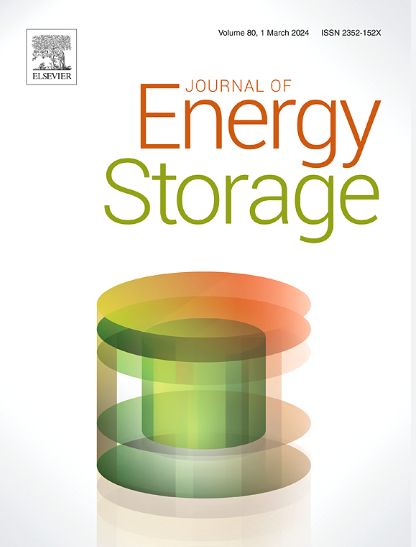Numerical investigation of particle wear and breakage effects on heat transfer mechanisms and conversion efficiency in energy storage fluidized beds
IF 8.9
2区 工程技术
Q1 ENERGY & FUELS
引用次数: 0
Abstract
Fluidized bed reactors are renowned for their excellent mixing and rapid heat transfer capabilities, making them widely used in thermochemical energy storage (TCES) systems. However, particle attrition can significantly affect heat transfer dynamics and system stability, especially under high-temperature reactive conditions. In this study, the spatiotemporal evolution of wear and breakage in a CaCO₃/CaO-based energy storage bed is simulated under a CFD-DEM framework, and their quantitative impacts on heat transfer and energy performance are analyzed. Results indicate that attrition are mainly concentrated in the middle and upper regions of the bed, with breakage primarily occurring in the core region—46.67 % of the total breakage occurs within the first 5 s. In contrast, wear mainly develops near the wall region, peaking at 28.68 % during the 15–20 s interval. Attrition increases radiative heat transfer by 10 % and nearly doubles conductive heat transfer, while also introducing a bimodal distribution in heating rate due to particle size variation. Although the average conversion rate and heat release efficiency are significantly enhanced, the reduction in bed porosity and particle kinetic energy negatively impacts bed fluidity and stability. This work provides new insights into the coupling between particle attrition and thermal behavior in reactive fluidized beds, offering guidance for optimizing particle design and reactor operation in TCES applications.
颗粒磨损和破碎对储能流化床传热机理和转化效率影响的数值研究
流化床反应器以其优异的混合和快速的传热能力而闻名,使其广泛应用于热化学储能(TCES)系统。然而,颗粒磨损会显著影响传热动力学和系统稳定性,特别是在高温反应条件下。在CFD-DEM框架下,模拟了CaCO₃/ cao基储能床的磨损与破碎的时空演化,并定量分析了其对传热和能量性能的影响。结果表明:磨蚀主要集中在中上层,破碎主要发生在岩心区域,46.67%的破碎发生在前5 s;磨损主要发生在近壁面区域,在15 ~ 20 s期间达到峰值,占28.68%。摩擦使辐射传热增加10%,传导传热增加近一倍,同时由于颗粒大小的变化,加热速率也出现双峰分布。虽然平均转化率和放热效率显著提高,但床层孔隙度和颗粒动能的降低对床层流动性和稳定性产生了负面影响。这项工作为反应流化床中颗粒磨损与热行为之间的耦合提供了新的见解,为优化颗粒设计和TCES应用中的反应器操作提供了指导。
本文章由计算机程序翻译,如有差异,请以英文原文为准。
求助全文
约1分钟内获得全文
求助全文
来源期刊

Journal of energy storage
Energy-Renewable Energy, Sustainability and the Environment
CiteScore
11.80
自引率
24.50%
发文量
2262
审稿时长
69 days
期刊介绍:
Journal of energy storage focusses on all aspects of energy storage, in particular systems integration, electric grid integration, modelling and analysis, novel energy storage technologies, sizing and management strategies, business models for operation of storage systems and energy storage developments worldwide.
 求助内容:
求助内容: 应助结果提醒方式:
应助结果提醒方式:


